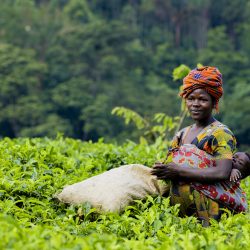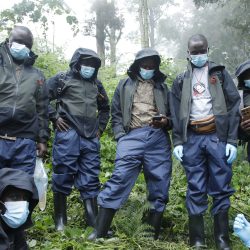Out and About in the Wild Treating Mountain Gorillas – A Gorilla Doctor’s Tale
Blog | 6/06/22
Dr. Julius Nziza together with his counterparts are committed to providing health care interventions to Mountain and Eastern lowland gorillas in the region. They visit the jungle at least thrice a week to check on the primates’ health. While in the field, the Gorilla Doctors look for symptoms of poor health including limping, wounds, low appetite, breathing complications and lethargy. And if a condition is considered life-threatening, the veterinarians swing into action to provide the appropriate treatment according to the diagnosis.
Mountain gorilla health care remains a crucial component for the long survival of the gentle giants. Thanks to the Gorilla Doctors https://www.gorilladoctors.org/about-us/ who have dedicated their lives to saving the Endangered sub-species. With the use of veterinary medicine and science – One Health approach they have effortlessly looked out for, treated, and saved the affected mountain gorillas.
While Gorilla Doctors acknowledge that mountain gorillas face several other threats including poaching, habitat loss and civil unrest, they reveal that diseases especially respiratory diseases are a major threat and the commonest issue on their treatment schedules. “Respiratory illnesses are very common among the mountain gorillas. They are also the second major cause of deaths among mountain gorillas,” reveals Dr. Bernard Jasper Ssebide, Country Head Veterinarian, Gorilla Doctors – Uganda. Respiratory infections are second in hierarchy following gorilla inflicted trauma caused by gorilla fights.
“Practices of poaching have significantly reduced, but infections and transmissions among mountain gorillas have not,” Dr. Nziza notes. Dr. Nziza adds that in the last four years in Rwanda, they have had two cases of mountain gorillas being caught in snares, while respiratory infection cases are reported and handled more regularly.
According to Dr. Nziza failure to conduct timely interventions in the case of acute respiratory illnesses could devastate an entire population. In 2009 for example, three individuals of the Hirwa Mountain gorilla group in Rwanda lost their lives due to respiratory illnesses.
Eddy Kambale Syaluha, Gorilla Doctors’ Head Veterinarian in DRC can’t agree more that a stich in time saves nine. Dr. Eddy however regrets to note that monitoring, let alone treating gorillas in DRC has remained impossible for some time due to insecurity. “Following the evacuation of ranger posts from the park due to rebel attacks, it has become increasingly risky to enter the park. We can’t help worrying and wondering how the gorillas that have fallen sick during this period have managed. We only hope that the situation normalizes soon so that we can get back to routinely monitoring and treating these fragile species.”
Treatment procedure
For about a decade now, Dr. Nziza who is also the Head Veterinarian in Rwanda has been handling several cases ranging from snare wounds/traps, viral and bacterial infections, cancer, to human-induced trauma due to injuries. “Each case is unique and must be dealt with differently! For instance, if the gorilla is suffering from human-induced injuries, like an injury from a snare, our field veterinarians dart it with anaesthestics to immobilize it, before they can treat it. The same happens in case of serious life-threatening diseases that require extensive treatment,” Dr. Nziza notes.
Dr. Nziza explains that they use sophisticated equipment called dart guns to anesthetize the animals. This intervention model requires at least two Gorilla Doctors or more attending to an individual gorilla. One goes to the group, with a darting gun carefully hidden from the sight of the gorillas, darts the animal, and quickly keeps the gun away because they do not want to alarm the group.
Darting is done from a distance with a lot of vigilance to ensure that these highly social primates are not threatened, or that they do not consider it as an attack that calls for a fight! The Gorilla Doctors on the other hand don’t want to put themselves in danger of being attacked by the rest of the family.
According to Dr. Nziza different groups react differently to such scenarios. Some are very protective of their members and thus get aggressive towards the veterinarians while some are calm and cooperative. Nziza recalls one experience when they were treating a young gorilla, and one of the Silverbacks in the group attacked them.
“One time we darted infant Agasozindatwa, and it was immobilized. But Guhonda, the then second in command Silverback from Sabyinyo group came and took the infant away and hid it in the bush. The trackers struggled to access the infant in vain until Guhonda released the baby. When we started treating it, Guhonda came charging at us again, making alarming vocalizations and ready to fight. It was tense, but we eventually treated the infant on that day,” narrates Dr. Nziza.
Every case is unique, and so, they venture into the forests expecting anything! However, working with energetic rangers and trackers helps the doctors to keep the curious gorilla group members under control or away allowing for the successful administration of the necessary diagnosis and treatment.
Not all cases of sickness require doctors to anesthetize the animals. Depending on the assessment, the doctors decide which approach to use. For instance, when a gorilla is suffering from a normal respiratory infection, they just load drugs into the darting gun and dart the animal.
Commenting on the process, Dr. Jean Bosco Noheli explains that after every treatment procedure, the doctors follow up on the sick animal on a regular basis to monitor its recovery. While a few animals succumb to some diseases, most of them recover. For example, 2021, Gorilla Doctors performed 35 clinical interventions across Volcanoes, Virunga, Mgahinga Gorilla and Bwindi Impenetrable National parks and all of them were successful.
“Seeing my patients recover well and grow up to become strong individuals swells my heart with pride. The turn-around recovery is great motivation to the team to keep doing what we do,” Dr. Noheli asserts. He adds “My most recent success was running a successful operation on adult female Turimaso who had an abscess on her lower lip. Her biopsy results equally turned negative for cancer. It was such a relief and joy.”




